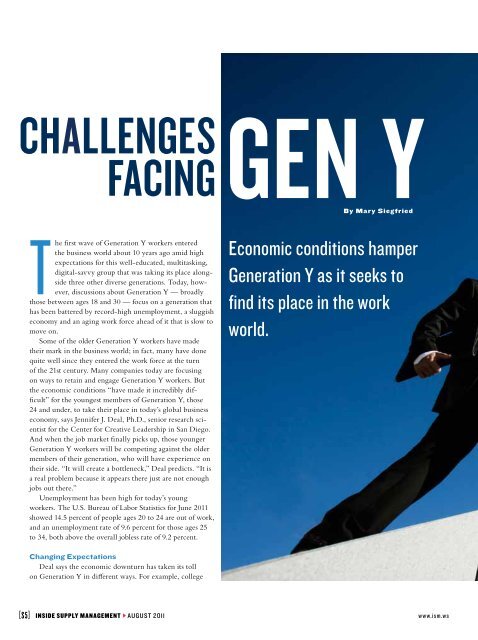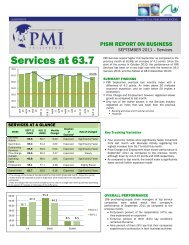Challenges FaCing gen Y - Philippine Institute for Supply ...
Challenges FaCing gen Y - Philippine Institute for Supply ...
Challenges FaCing gen Y - Philippine Institute for Supply ...
Create successful ePaper yourself
Turn your PDF publications into a flip-book with our unique Google optimized e-Paper software.
<strong>Challenges</strong><br />
Facing Gen Y<br />
By Mary Siegfried<br />
The first wave of Generation Y workers entered<br />
the business world about 10 years ago amid high<br />
expectations <strong>for</strong> this well-educated, multitasking,<br />
digital-savvy group that was taking its place alongside<br />
three other diverse <strong>gen</strong>erations. Today, however,<br />
discussions about Generation Y — broadly<br />
those between ages 18 and 30 — focus on a <strong>gen</strong>eration that<br />
has been battered by record-high unemployment, a sluggish<br />
economy and an aging work <strong>for</strong>ce ahead of it that is slow to<br />
move on.<br />
Some of the older Generation Y workers have made<br />
their mark in the business world; in fact, many have done<br />
quite well since they entered the work <strong>for</strong>ce at the turn<br />
of the 21st century. Many companies today are focusing<br />
on ways to retain and engage Generation Y workers. But<br />
the economic conditions “have made it incredibly difficult”<br />
<strong>for</strong> the youngest members of Generation Y, those<br />
24 and under, to take their place in today’s global business<br />
economy, says Jennifer J. Deal, Ph.D., senior research scientist<br />
<strong>for</strong> the Center <strong>for</strong> Creative Leadership in San Diego.<br />
And when the job market finally picks up, those younger<br />
Generation Y workers will be competing against the older<br />
members of their <strong>gen</strong>eration, who will have experience on<br />
their side. “It will create a bottleneck,” Deal predicts. “It is<br />
a real problem because it appears there just are not enough<br />
jobs out there.”<br />
Unemployment has been high <strong>for</strong> today’s young<br />
workers. The U.S. Bureau of Labor Statistics <strong>for</strong> June 2011<br />
showed 14.5 percent of people ages 20 to 24 are out of work,<br />
and an unemployment rate of 9.6 percent <strong>for</strong> those ages 25<br />
to 34, both above the overall jobless rate of 9.2 percent.<br />
Economic conditions hamper<br />
Generation Y as it seeks to<br />
find its place in the work<br />
world.<br />
Changing Expectations<br />
Deal says the economic downturn has taken its toll<br />
on Generation Y in different ways. For example, college<br />
[ S5]<br />
Inside supply management August 2011 www.ism.ws
www.ism.ws August 2011 Inside supply management [ S6]
<strong>Challenges</strong> Facing Gen Y<br />
career service professionals report that<br />
students’ career expectations have<br />
changed in recent years. Many are not<br />
optimistic about their job prospects<br />
and are lowering expectations about<br />
what to expect if they do find work.<br />
“That does not mean they are not<br />
going to ask <strong>for</strong> more when they have<br />
a job prospect. They have been taught<br />
by their baby boomer parents to ask<br />
<strong>for</strong> everything they want,” Deal says.<br />
“But what they ask <strong>for</strong> and what they’re<br />
expecting are not necessarily the same<br />
thing.” She adds that Generation Y may<br />
become a <strong>gen</strong>eration that is consistently<br />
underemployed.<br />
Generation Y, also known as<br />
Millennials, has been slow to gain<br />
its economic footing, she adds. Deal<br />
says there is substantial evidence that<br />
employees who enter the work <strong>for</strong>ce<br />
during a downturn experience a longterm<br />
earnings impact. The reason is<br />
simple — starting pay is usually lower<br />
during a tough economy. A worker<br />
may start at US$35,000 and receive a 3<br />
percent increase each year, <strong>for</strong> example,<br />
but that accumulates far less than if a<br />
worker started out making $40,000 a<br />
year. “It is cumulative, and over time<br />
it means that those workers will likely<br />
earn substantially less money than their<br />
peers who start the same job at a higher<br />
salary because they are entering the<br />
work <strong>for</strong>ce in a better economy.”<br />
Jeff Schwartz, principal <strong>for</strong> Deloitte<br />
Consulting LLP in McLean, Virginia,<br />
divides Generation Y into two groups.<br />
He uses September 15, 2008, the fall<br />
of Lehman Brothers, as the hallmark<br />
of the recession and the financial crisis.<br />
The pre-9/15/08 Gen Y workers<br />
entered the workplace with significant<br />
opportunities, and many of those<br />
young workers were in high demand<br />
and well-treated in the workplace.<br />
The post-9/15/08 group “really got<br />
slammed and hit the wall when they<br />
entered the job market,” he says. In<br />
fact, some are labeling this group “the<br />
lost <strong>gen</strong>eration.”<br />
On the Move<br />
Companies, however, should not<br />
assume their Generation Y employees<br />
will stay put because of the slowly<br />
recovering economy. In fact, Schwartz<br />
says research shows that many Gen Y<br />
workers are getting restless. “They have<br />
done well and are glad to have jobs,<br />
but they are really itching <strong>for</strong> a change.<br />
And they’re looking <strong>for</strong> it either in their<br />
Generation Y<br />
Characteristics<br />
Some <strong>gen</strong>eral characteristics about<br />
Generation Y include:<br />
• They believe in a strong work-life<br />
balance.<br />
• They are <strong>gen</strong>erally com<strong>for</strong>table<br />
with diversity and globalization.<br />
• Generation Y understands competition<br />
because many faced stiff<br />
competition getting into colleges,<br />
<strong>for</strong> example.<br />
• They are com<strong>for</strong>table with trying<br />
out new things, whether it is a new<br />
product or a new job.<br />
• It is a <strong>gen</strong>eration that enjoys<br />
working in teams and expects to<br />
be recognized <strong>for</strong> per<strong>for</strong>mance in<br />
teamwork.<br />
company or outside,” he says. “The<br />
surveys we are doing show that the<br />
turnover intentions of Generation Y are<br />
very high. So if you have skilled young<br />
people in your organization who you<br />
think are keepers, you need to be proactive<br />
in giving them a reason to stay,”<br />
he explains.<br />
Schwartz says he believes the second<br />
half of 2011 is shaping up to be a “fairly<br />
good” recruiting season <strong>for</strong> young<br />
workers with critical skills such as engineering,<br />
finance, supply management<br />
and R&D. A Deloitte survey, Talent<br />
Edge 2020: Blueprint <strong>for</strong> the New Normal,<br />
found that high unemployment rates<br />
in the United States and abroad have<br />
not created the talent surplus many<br />
predicted. For example, executives surveyed<br />
predict talent shortages in R&D<br />
and executive leadership — positions<br />
which are needed to fuel innovation<br />
and growth. He calls this the talent<br />
paradox. “The challenge in the talent<br />
market today is not the availability<br />
of people who want to work, but the<br />
availability of those with skills you need<br />
at prices you want to pay,” he says.<br />
X Comes Be<strong>for</strong>e Y<br />
In addition to concerns about having<br />
skilled employees available <strong>for</strong> jobs once<br />
the economy strengthens, there also is<br />
a complicated numbers game involving<br />
talent and the <strong>gen</strong>erations, Deal says.<br />
The baby boomers and Generation<br />
Y are large <strong>gen</strong>erations, but tucked<br />
in the middle of them is the smaller<br />
Generation X, those born between<br />
1964 and 1980. So while there are<br />
plenty of Generation Y workers to take<br />
over <strong>for</strong> baby boomers once they move<br />
on, they can’t always leapfrog over<br />
Generation X because they <strong>gen</strong>erally<br />
don’t have the needed skills and experience<br />
to do the work. It’s unlikely that<br />
a 29-year-old is going to take over the<br />
job of a 65-year-old baby boomer.<br />
“So the business world will be<br />
looking to Generation X to fill the<br />
baby boomers’ places, but <strong>for</strong> every 10<br />
boomers there are only nine Gen Xers,<br />
so that is one place where there could be<br />
a talent shortage,” she explains. “What<br />
people are missing is the potential<br />
problem of not enough workers with the<br />
necessary experience to move into open<br />
positions in the years ahead.” The positive<br />
side of the equation <strong>for</strong> companies,<br />
but lingering challenge <strong>for</strong> Generation<br />
Y, is that baby boomers are not retiring<br />
the way they were expected to, opting<br />
to stay longer in the work <strong>for</strong>ce because<br />
of the economic situation and simply<br />
because they want to work longer.<br />
Bridge the Gap<br />
Despite the current challenging job<br />
market, Generation Y eventually will<br />
[ S7]<br />
Inside supply management August 2011 www.ism.ws
fully take its place in the work world.<br />
That’s why employers need to understand<br />
Generation Y’s priorities, work<br />
style and ways to attract Generation Y<br />
workers around the world in today’s<br />
global economy.<br />
Schwartz says Generation Y is different<br />
in both “fundamental and interesting<br />
ways.” He calls them true digital<br />
natives who learn and work differently<br />
than the <strong>gen</strong>erations sitting next to them<br />
in the workplace. “This is the <strong>gen</strong>eration<br />
that grew up multitasking, but they<br />
don’t see it as multitasking; it is just the<br />
way they live and work.” They have<br />
always been wireless and never tethered<br />
to a desk, computer or phone. “So<br />
depending on their jobs, they believe<br />
they can work anywhere, anytime,” he<br />
says. “There is a new normal around the<br />
way Generation Y thinks of work.”<br />
Deal says Generation Y is typically<br />
well-educated — it has a higher<br />
percentage of college degrees than<br />
any <strong>gen</strong>eration be<strong>for</strong>e it. Gen Y also<br />
understands the need to be continuous<br />
learners. “Organizations that provide<br />
time and financial support <strong>for</strong> continuing<br />
education will be much more<br />
attractive to the best and the brightest<br />
of this <strong>gen</strong>eration,” she explains.<br />
Compensation is, of course, important<br />
to Generation Y, but in a unique<br />
way. Schwartz says Gen Y workers<br />
expect they will be paid well, but they<br />
also have high expectations around<br />
nonfinancial issues. He says young<br />
workers are interested in a company’s<br />
culture and values around social and<br />
community involvement. “Community<br />
involvement is something that attracts<br />
them and keeps them at a company.<br />
It is a <strong>gen</strong>eration that appreciates that<br />
they can contribute to the community<br />
through their business organization,”<br />
he adds.<br />
Generation Y has its unique attributes<br />
because, like all <strong>gen</strong>erations, it<br />
reflects the culture in which it grew up.<br />
Deal says, however, when a new <strong>gen</strong>eration<br />
begins taking its place in the business<br />
world, the <strong>gen</strong>erations are more<br />
alike than different. “Workers want<br />
to be respected, paid well, per<strong>for</strong>m<br />
interesting work, be with coworkers<br />
and managers they like and respect,<br />
and have the opportunity to move up,<br />
to learn and develop,” she explains. In<br />
those basic employment goals, <strong>gen</strong>erations<br />
have been consistent over time. ISM<br />
Mary Siegfried is a senior writer <strong>for</strong> Inside <strong>Supply</strong> Management ® .<br />
For more in<strong>for</strong>mation, send an e-mail to author@ism.ws.<br />
Generation Y Around the World<br />
Because companies operate around the world, business leaders need to understand the various <strong>gen</strong>erations of workers in a global<br />
context. Just as executives need to understand that customers are different depending on where they live around the world, Generation<br />
Y is not the same in every country, says Jeff Schwartz, principal <strong>for</strong> Deloitte Consulting LLP. In the article Talking about<br />
Whose Generation?, Schwartz, David Hole and Le Zhong examine <strong>gen</strong>erations in several emerging economies.<br />
Some of the findings in the Deloitte article include:<br />
In China, workers born between 1980 and 1989 are the first <strong>gen</strong>eration of single children after the introduction of the One Child<br />
Policy, growing up in an environment of high expectations. As a group, this <strong>gen</strong>eration has a reputation <strong>for</strong> being “individualistic and<br />
confident but also self-centered and rebellious.” Compared with other <strong>gen</strong>erations in China, they are regarded as innovative<br />
and open-minded toward new ideas and approaches.<br />
In India, Generation Y workers have fully embraced a career model of rotation among employers as<br />
they pursue career advancement. They value talent programs that meet their development needs<br />
and opportunities <strong>for</strong> advancement, such as the opportunity to work globally.<br />
In Japan, the employment attitude of those born toward the end of the bubble<br />
economy (1986-1995), known as Generation Z, were shaped by their parents’ struggles<br />
during the Japanese recession. These workers “typically demonstrate a clear<br />
bias toward stable corporate jobs and have benefited from opportunities created<br />
by the economic recovery and the retirement of the first baby boomers.”<br />
In the article, Schwartz encourages global companies to create countryspecific<br />
talent strategies, rather than standardizing talent management<br />
plans, and suggests working with local leaders who understand the different<br />
aspirations of the <strong>gen</strong>erations that make up the work <strong>for</strong>ce.<br />
© <strong>Institute</strong> <strong>for</strong> <strong>Supply</strong> Management . All rights reserved. Reprinted with permission from the publisher, the <strong>Institute</strong> <strong>for</strong> <strong>Supply</strong> Management .<br />
www.ism.ws August 2011 Inside supply management [ S8]






